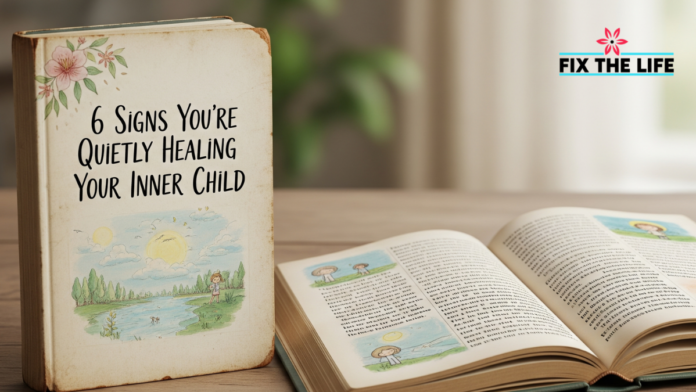Healing your inner child is one of the most profound forms of self-growth. It involves recognizing past wounds, rebuilding emotional security, and learning to nurture yourself in ways you may have missed as a child. While healing is often subtle, certain signs indicate you’re making significant progress.
This guide explores six key signs you’re healing your inner child, the self-healing stages, and how inner child work fosters emotional resilience.
1. You Show More Self-Compassion Instead of Self-Criticism
One of the strongest indicators of inner child healing is self-compassion. Instead of engaging in harsh self-talk, you offer yourself kindness and patience.
Signs of Self-Compassion:
- You don’t punish yourself for making mistakes.
- You acknowledge emotions without judgment.
- You speak to yourself with warmth rather than criticism.
Example: If you forget an important task, instead of thinking, “I’m so irresponsible,” you say, “I made a mistake, and that’s okay—I can handle this.”
Self-compassion nurtures emotional stability, allowing inner wounds to soften.
2. You Feel Safer Expressing Your Emotions
Emotional suppression is a defense mechanism developed in childhood, especially in environments where expressing feelings was discouraged. Healing involves relearning emotional safety.
Signs of Emotional Freedom:
- You no longer hide sadness or vulnerability.
- You allow yourself to experience joy without guilt.
- You recognize emotions as valid rather than weaknesses.
Example: If disappointment arises, instead of repressing it, you say, “This hurts, and I deserve to acknowledge my feelings.”
The ability to feel freely is a breakthrough in inner child work.
3. You Set Boundaries Without Feeling Guilty
Many people with wounded inner children struggle to prioritize their needs, fearing rejection or conflict. Healing helps you realize that boundaries are not selfish—they are essential for emotional safety.
Signs of Healthy Boundaries:
- You say “no” without over-explaining.
- You protect your time and energy without guilt.
- You avoid tolerating disrespect or emotional manipulation.
Example: If someone pressures you into an uncomfortable situation, you respond confidently with, “I appreciate the invite, but I’m not available for this.”
Boundaries reinforce self-worth, ensuring your needs are honored.
4. You Enjoy Activities That Once Brought You Joy
Inner child healing reconnects you with the simple joys you once loved, allowing you to re-experience carefree happiness.
Signs of Reconnecting with Joy:
- You indulge in hobbies from childhood (drawing, dancing, playing games).
- You no longer feel ashamed of being playful or imaginative.
- You experience excitement in small, everyday moments.
Example: You once loved painting but lost touch with it as an adult—now, you pick up a brush again and allow yourself creative freedom.
Joyful reconnection reminds your inner child that happiness is safe.
5. You Stop Seeking Validation & Approval
If validation was scarce in childhood, you may have developed a need for external approval. Healing involves reclaiming confidence without relying on others to define your worth.
Signs of Internal Validation:
- You trust your own decisions without needing excessive reassurance.
- You no longer change yourself to fit others’ expectations.
- You recognize that self-worth doesn’t depend on outside approval.
Example: Instead of needing compliments or validation to feel good about your achievements, you celebrate your own growth internally.
Self-worth healing ensures you trust your own value rather than waiting for others to confirm it.
6. You Forgive Yourself & Let Go of Past Shame
Many people carry guilt or shame linked to childhood mistakes, past choices, or emotional wounds. Healing involves releasing unnecessary guilt and embracing self-forgiveness.
Signs You’re Letting Go:
- You stop replaying past failures in your mind.
- You accept that childhood wounds weren’t your fault.
- You focus on the present instead of lingering in regret.
Example: Instead of thinking, “I wish I had done things differently back then,” you say, “I did the best I could with what I knew at the time.”
Forgiveness frees your inner child from burdens they were never meant to carry.
FAQs
Q1: What is inner child work, and why does it matter?
Inner child work involves addressing emotional wounds from childhood, helping individuals nurture self-compassion, emotional security, and personal growth.
Q2: How do I know if I need to heal my inner child?
If you experience patterns of self-doubt, guilt, emotional suppression, or validation-seeking, inner child healing may be beneficial.
Q3: Can inner child work help with relationships?
Yes! Healing creates healthier emotional boundaries, improving the way you connect with partners, friends, and family.
Q4: What are some simple ways to reconnect with my inner child?
Engaging in play, creativity, emotional expression, and self-care practices can restore childhood joy and emotional balance.
Q5: How long does inner child healing take?
There’s no set timeline—it’s a gradual process of self-awareness, growth, and emotional rewiring. The key is consistency in self-compassion.
Final Thought
Recognizing the signs you’re healing your inner child is a powerful step in self-growth. Whether you’re rebuilding emotional safety, setting boundaries, reconnecting with joy, or reclaiming self-worth, each milestone brings newfound confidence and peace. Healing isn’t about erasing the past—it’s about embracing self-love, ensuring your inner child finally feels safe, heard, and valued.




